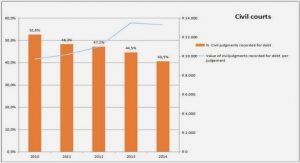Get Complete Project Material File(s) Now! »
Formation of Fly Ash
There are two major technologies that can be used to combust coal, namely, fluidised bed combustion (FBC) and pulverised coal combustion (PCC). The principal difference between FBC and PCC technologies lies in the temperature and residence time of coal in the combustion chamber. The former operates at temperatures between 800 and 900 ºC in the presence of an absorbent such as limestone to capture over 90% of sulphur (Haynes, 2009). This temperature range is below the fusion temperature for most silicate minerals hence FBC fly ash contains a high concentration of crystalline phases, iron oxide and anhydrite (Haynes, 2009; Tishmack and Burns, 2004; Glasser, 2004). In the circulating configuration, the coal particles can spend up to several minutes in combustion chamber while the residence time is about 4 – 7 seconds in the case of PCC (Kruger, 2010). The principal benefit of FBC technology is its mitigation of sulphur dioxide and nitrogen oxides emissions (Baba et al., 2010; Glinicki and Zieliński, 2008) as well as the ability to combust low-quality coal. On the other hand PCC operates between 1 300 and 1 700 ºC which is above the fusion temperature of most minerals thereby resulting in the formation of high content of amorphous or non-crystalline (glassy) phase; during rapid cooling (Kutchko and Kim, 2006; Glasser, 2004; Haynes, 2009; Font et al., 2010). From their origin it is evident that these fly ashes differ in many aspects (Sulovský, 2002). At present no power station uses FBC technology to combust coal in South Africa hence subsequent discussions are limited to PCC fly ash.
Status Quo
South Africa and many other countries such as Poland, United States of America, India and China rely on coal as a primary source of energy (Vejahati et al., 2010; Meawad et al., 2010). The coal combustion process yields vast quantities of fly ash which require disposal or storage in a responsible manner (Baba et al., 2010; Pandian, 2004; Wiszniowski et al., 2007; Kumar, 2004; Donahoe et al., 2007; Kostakis, 2009). Some countries are considering the classification of coal ash as a hazardous material (Diaz et al., 2010; Fongsatitkul et al., 2009). Environmentalists and the public have a concern about coal ash despite its utilisation applications which include addition in cement and concrete manufacturing, agriculture, and waste stabilisation (Ahmaruzzaman, 2010; Cheng, 2005; Mahlaba and Pretorius, 2006; Fernández-Pereira et al., 2002; Shang and Wang, 2005; Ilgner, 2002; Kruger and Krueger, 2005; Pandian, 2004; Gitari et al., 2008; Kearsley and Wainwright, 2003; Kruger and Surridge, 2009; Haynes, 2009; Pengthamkeerati et al., 2010; Truter et al., 2001). SASOL (petrochemical) and ESKOM (power utility) are the largest coal processing companies in the Southern Africa. All their facilities are situated inland (van Dyk et al., 2006; Feeley, 2003; Sheng et al., 2003). South Africa produces in excess of 30 million tons of fly ash per annum of which only 5% is utilised (Bada and Potgieter-Vermaak, 2008; Gitari et al., 2009). Generally ash utilisation only consumes a small fraction of total fly ash production (Antiohos and Tsimas, 2004; Ahmaruzzaman, 2010) leaving the majority for onsite disposal or landfilling. The latter is becoming increasingly more costly especially since rehabilitation of onsite disposal sites is required before closure (Haynes, 2009; Ahmaruzzaman, 2010). Authorities are also reluctant to issue new permits for waste disposal sites (Ciccu et al., 2003).
Chapter 1: Introduction
1.1 Background
1.2 Operational Challenges
1.3 Objectives
1.4 Hypothesis
1.5 Scope of Research
1.6 Methodology
1.7 Organisation of the Thesis
Chapter 2: Literature Review and Hypothesis
2.1 Introduction
2.2 Brines
2.3 Fly Ash
2.4 Ash Disposal Systems
2.5 Weathering
2.6 Cement Chemistry
2.7 Case Studies on Ash Disposal
2.8 Paste as a Proposed Solution
Chapter 3: Experimental Procedures
3.1 Introduction
3.2 Materials
3.3 Research Methodologies
3.4 Physical Characteristics
3.5 Solid State Chemistry
3.6 Concluding Remarks
Chapter 4: Drilling and Characterisation of a FAD
4.1 Introduction
4.2 Fine Ash Dam Construction
4.3 Drilling
4.4 Results and Discussion: Weathered Fine Ash
4.5 Fresh Slurry
4.6 Effect of Curing Time on FA Properties
4.7 Conclusions
Chapter 5: Results and Discussion
5.1 Background
5.2 Effect of brine composition
5.3 Influence of Brine Salinity
5.4 Evaluation of Chlorides Compounds
5.5 Evaluation of Sulphate Compounds
5.6 Development of Predictive Brine Protocol (Model)
5.7 Characterisation of Cured Pastes
5.8 Influence of Fly Ash
5.9 Conclusions
Chapter 6: Comparison of Hydraulic Disposal and Paste Placement
6.1 Introduction
6.2 Selected Results
6.3 Concluding Remarks
Chapter 7: Conclusions and Recommendations
7.1 Background
7.2 Conclusions from Laboratory Experiments
7.3 Conclusions from the Field Investigation
7.4 Implications to Sustainability
7.5 Recommendations of Future Work






